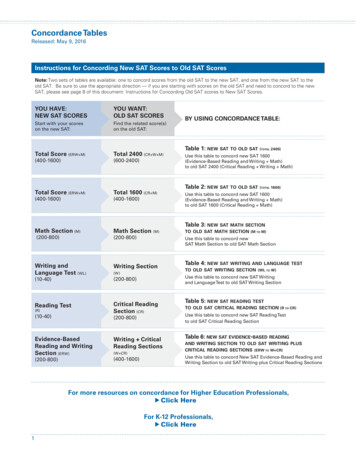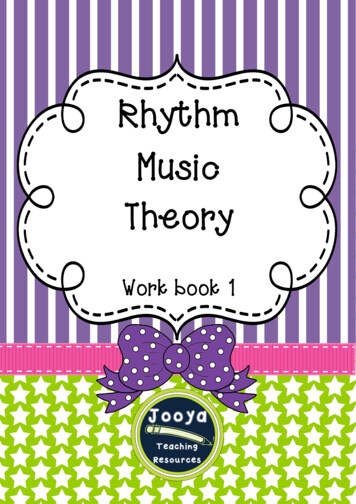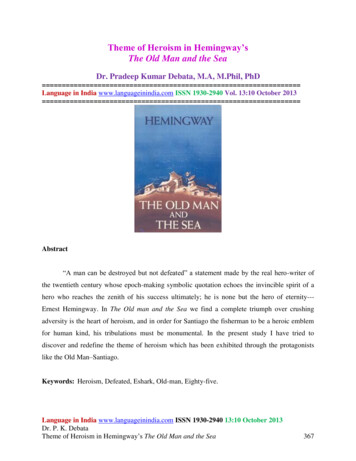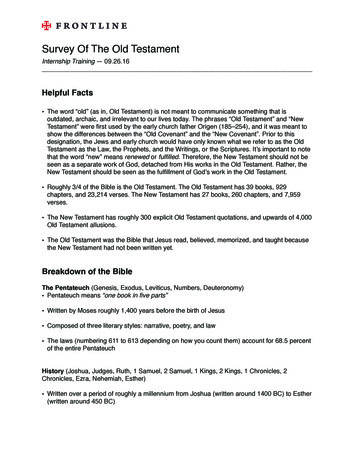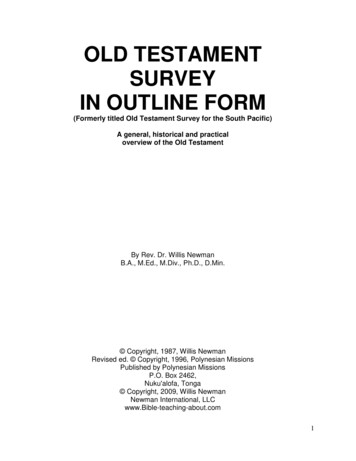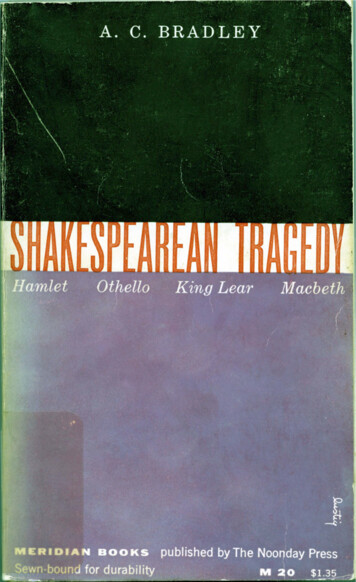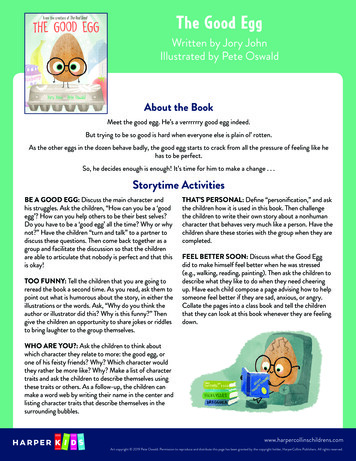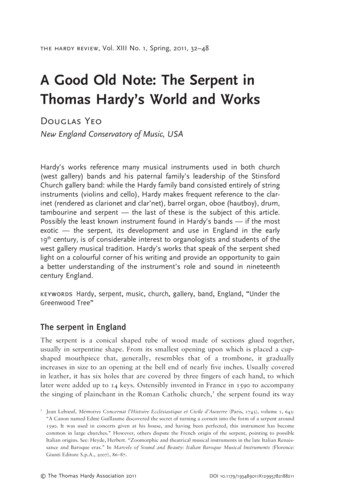
Transcription
the hardy review, Vol. XIII No. 1, Spring, 2011, 32–48A Good Old Note: The Serpent inThomas Hardy’s World and WorksDouglas YeoNew England Conservatory of Music, USAHardy’s works reference many musical instruments used in both church(west gallery) bands and his paternal family’s leadership of the StinsfordChurch gallery band: while the Hardy family band consisted entirely of stringinstruments (violins and cello), Hardy makes frequent reference to the clarinet (rendered as clarionet and clar’net), barrel organ, oboe (hautboy), drum,tambourine and serpent — the last of these is the subject of this article.Possibly the least known instrument found in Hardy’s bands — if the mostexotic — the serpent, its development and use in England in the early19th century, is of considerable interest to organologists and students of thewest gallery musical tradition. Hardy’s works that speak of the serpent shedlight on a colourful corner of his writing and provide an opportunity to gaina better understanding of the instrument’s role and sound in nineteenthcentury England.keywords Hardy, serpent, music, church, gallery, band, England, “Under theGreenwood Tree”The serpent in EnglandThe serpent is a conical shaped tube of wood made of sections glued together,usually in serpentine shape. From its smallest opening upon which is placed a cupshaped mouthpiece that, generally, resembles that of a trombone, it graduallyincreases in size to an opening at the bell end of nearly five inches. Usually coveredin leather, it has six holes that are covered by three fingers of each hand, to whichlater were added up to 14 keys. Ostensibly invented in France in 1590 to accompanythe singing of plainchant in the Roman Catholic church,1 the serpent found its way1Jean Lebœuf, Mémoires Concernat l’Histoire Ecclésiastique et Civile d’Auxerre (Paris, 1743), volume 1, 643:“A Canon named Edmé Guillaume discovered the secret of turning a cornett into the form of a serpent around1590. It was used in concerts given at his house, and having been perfected, this instrument has becomecommon in large churches.” However, others dispute the French origin of the serpent, pointing to possibleItalian origins. See: Heyde, Herbert. “Zoomorphic and theatrical musical instruments in the late Italian Renaissance and Baroque eras.” In Marvels of Sound and Beauty: Italian Baroque Musical Instruments (Florence:Giunti Editore S.p.A., 2007), 86–87. The Thomas Hardy Association 2011DOI 10.1179/193489011X12995782188211
A GOOD OLD NOTE33figure 1 Johann Zoffany, The Sharp Family, 1779–1781, by permission of the NationalPortrait Gallery and the Lloyd-Baker Trustees, catalogue NPG L169.into orchestras and military bands in France and Germany before coming to Englandwhere it was used in many types of musical ensembles throughout the mid-19thcentury.2In its original serpentine form as developed in France, the serpent was held vertically between a player’s legs, a posture devised for playing while seated or leaningagainst a misericord in a choir stall. Johann Zoffany’s celebrated painting from 1781(Figure 1), The Sharp Family, shows James Sharp with his French serpent d’église,held in the traditional manner.3 But this position was ill-suited for holding the serpentwhile on the march and subsequently serpents began to be held horizontally.The earliest documented view of this new way of holding the serpent (whichrequired the fingering of the right hand to be reversed when the instrument was held23The serpent appeared in England as early as 1695 but was not employed widely until after 1785. An extensivehistory of the serpent may be found in Clifford Bevan, The Tuba Family (Winchester: Piccolo Press, 2000second edition), 63–126.See: Brian Crosby, “Private Concerts on Land and Water: The Musical Activities of the Sharp Family,c. 1750–c. 1790,” Royal Musical Association Research Chronicle, No. 34 (2001), 1–118.
34DOUGLAS YEOfigure 2 Artist unknown, detail, The Courtyard at St James’s Palace c. 1790, by permissionof The Trustees of the British Museum, catalogue 1880, 1113.2137.with the right hand “palm up”) is found in an anonymous print of a band at St James’Palace c. 1790 (Figure 2). It is possible this is a representation of the first officialmilitary band in England that employed the serpent. This band, attested on May 16,1785, was brought to England from Hanover by the Duke of York to serve as theband of the Coldstream Guards.4 The player in the print is utilizing the horizontalplaying position that became standard in England from that time forward.While the serpent was known in England before 1785 — most notably being usedin John Eccles’ opera Rinaldo and Armida (1698) and music for Macbeth (1700), itsappearance in the original score of Handel’s Music for the Royal Fireworks (1749),and in Samuel Wesley’s March (1777) — it is likely that instruments used at that timewere French in origin, as is the case in James Sharp’s specimen. Yet with the introduction of German serpents and the horizontal playing position by the Duke of York’sband from Hanover, the serpent began to undergo an evolution in form that led towhat we call today the “English military serpent.” It was this instrument that found4For a full treatment of this important development in English military bands, see David B. Diggs, OriginalMembers of the Duke of York’s Band (paper presented to the Lawrence Henry Gipson Institute for EighteenthCentury Studies, Lehigh University, Bethlehem, Pennsylvania, April 2009). Also, W.T. Parke, Musical Memoirs:Comprising an Account of the General State of Music in England, from the First Commemoration of Handel,in 1784, to the Year 1830 (London: Henry Colburn and Richard Bentley, 1830; reprint, New York: Da CapoPress, 1970), 239–241. Also, Henry George Farmer, The Rise & Development of Military Music (London:William Reeves, 1912), 69–70.
A GOOD OLD NOTE35its place in the west gallery church bands of the early nineteenth century and wasknown by Thomas Hardy.The development of the English military serpentTaking as their model the traditional French serpent d’église and the horizontal playing orientation introduced to Britain by the German band from Hanover, Englishmakers undertook the task of making serpents for an ever-increasing number ofmilitary bands. The London maker Longman and Broderip was advertising(Figure 3), as early as 1796 (and possibly much earlier), serpents supplied to commanders of Regiments, “on reasonable terms, and at the shortest notice.”What these serpents looked like is not definitely known since few serpent makerssigned or stamped their instruments. An unsigned serpent in Colchester and IpswichMuseums (Figure 4) — most likely English in origin given its similarity to someearly English serpents that are covered with paper mâché, newspaper or cloth beforebeing clumsily wrapped in leather — is an early “transitional” instrument that, whilefigure 3Detail, London Oracle, Friday, October 14, 1796.
36DOUGLAS YEOfigure 4 Serpent (unsigned, probably English), late 18th century?, by permission ofColchester and Ipswich Museum Service, catalogue COLEM 1935.408.clearly a close ancestor of the French church serpent, exhibits distinctive features thatwould later be incorporated into the classic English military serpent.The fifth finger hole has been drilled slightly closer to the outer edge of the lastbend to allow for the length of a player’s middle finger on his right hand when playing in the palm up position. Further, the first tube has been turned inward towardthe second bend, thereby making the instrument a bit more compact. The brace(or, “stay”) between the first and second tubes is a recent replacement.The symbiotic relationship between military bands — many of which were localand not Regimental — and church bands resulted in individual players beingmembers of both kinds of ensembles.5 The churchyard of the Parish Church of AllSaints in Minstead (Winchester) boasts the grave of Thomas Maynard, serpentplayer with the Band of Musicians of the 8th Hants (Hampshire) Yeomanry who diedin 1807 and very likely played in the church’s band.6The exquisite carved image of a serpent on Maynard’s grave stone (Figure 5) ishighly detailed, and shows further developments in serpent construction includingtwo metal stays between bends — to add greater strength — and a metal mount onthe bell that served to protect the instrument from the rigours of outdoor and tight,indoor space (such as church galleries) play. The serpent shows its continuedevolution toward a more compact shape.Regrettably stolen and thereby unavailable for inspection, a serpent formerlyplayed in Upper Beeding Church (Figure 6) is known by a photograph in CanonMacDermott’s book and also shows a variety of transitional characteristics includingthe compact form and two stays. While it did not have a bell mount, the holes were56K. H. MacDermott, The Old Church Gallery Minstrels: An Account of the Church Bands and Singers inEngland from about 1660 to 1860 (London: S.P.C.K., 1948), 29–30.If this modest church and its yard are known by the greater public, it is because its yard is the final restingplace for Sir Arthur Conan Doyle (1859–1930) and his wife, Jean (d. 1940).
A GOOD OLD NOTE37figure 5 Grave of Thomas Maynard (1807), Parish Church of All Saints, Minstead, Dioceseof Winchester. Photograph by the author.figure 6 Serpent from Upper Beeding Church, West Sussex (unsigned, late 18th century?),by permission of S.P.C.K. Publishing; from K. H. MacDermott, The Old Church GalleryMinstrels, 1948. Photograph by W. Bax.“bushed” with ivory inserts that allowed the player’s fingers to more convenientlyfind their proper position.Of particular interest is an unsigned serpent (Figure 7) collected by Charles Wade(1883–1956) — on display in his former home, Snowshill Manor (Gloucestershire)— that has no stays but has a brass bell mount and three keys (two on the front andone on the back). The bottommost key — used for the note C sharp and to “vent”
38DOUGLAS YEOfigure 7 Serpent (unsigned, late 18th century?), by permission of the Music Room, Snowshill Manor (National Trust), Gloucestershire, catalogue SNO/MC/38. Photograph by theauthor.other notes to improve their tone — was originally on the front of the instrumentbefore the hole and key saddle were filled in and relocated to the back. Positioningthis key on the front may have meant the serpent was held vertically at one time. Inthis respect the Snowshill Manor serpent may be a long sought for “missing link”:a serpent that underwent a significant change during its playing lifetime to changefrom the vertical to the horizontal playing orientation. The compact shape is accompanied by a narrower bore and wooden walls that are thicker than the French churchserpent and it has a combination of “U” and “V” shaped bends. These were amongthe final important modifications of the serpent as the English-made instrumentcontinued its rapid march to its classic form.While the English serpent underwent additional changes through the early 19thcentury — most notably the addition of more keys — its classic form is that of asigned serpent by William Millhouse (Figure 8) that dates from the first decade of the1800s. Bell mount, three metal stays between sections, ivory finger hole bushings,three keys (including the C sharp key positioned on the back) and the by now familiar compact shape have, in this instrument, all become firmly established, and it isthe serpent in this form that would have been known to Thomas Hardy’s ancestorsand which made an appearance in so many of his works.Thomas Hardy and the serpentIn his pseudonymous biography, The Life and Work of Thomas Hardy, Hardy speaksin detail of the contributions of his grandfather, Thomas Hardy Senior (1778–1837)
A GOOD OLD NOTE39figure 8 Serpent by William Milhouse, London, c. 1800[?], by permission of the BateCollection, Oxford, catalogue 519. Photograph by Andrew Lamb.and his father, Thomas Hardy Junior (1811–1892), both of whom played in thegallery band at Stinsford Church.7 Thomas Hardy Senior played cello in PuddletownChurch before 1800 and in Stinsford from 1802 until his death in 1837. His son playedtenor violin (that is, viola8) in the band from his youth (no date is cited) to 1841 or1842. Hardy’s uncle, James Hardy (1805–1880), also played violin at StinsfordChurch.Hardy writes about the differences between the band in Stinsford and that ofchurches in neighbouring towns,Thus it was that the Hardy instrumentalists, though never more than four, maintainedan easy superiority over the larger bodies in parishes near. For while Puddletown westgallery, for instance, could boast of eight players, and Maiden Newton of nine, theseincluded wood-wind and leather — that is to say, clarionets and serpents — which wereapt to be a little too sonorous, even strident, when zealously blown.9Here Hardy is making a distinction between the all-string band of Stinsford(Mellstock in his works) and the bands of Puddletown (Weatherbury) and Maiden789Thomas Hardy, The Life and Work of Thomas Hardy, ed. Michael Millgate (Athens, Georgia: University ofGeorgia Press, 1985), 14.Elna Sherman, “Music in Thomas Hardy’s Life and Work,” The Musical Quarterly, 26.4 (October 1940),420.Life, 14.
40DOUGLAS YEONewton (Chalk Newton) that had wind instruments in addition to strings. Hardy’sreference to the serpent as being “a little too sonorous, even strident, when zealouslyblown,” shows he was well aware of this characteristic of the instrument when inthe hands of an over-enthusiastic or less-accomplished player. The military serpent,owing to its narrow bore and thick wooden walls, was particularly susceptible toproducing a strident tone in less skilled hands.Yet Hardy had an affection for the serpent, if principally because it was areminder of times past. His most extensive comment on the serpent comes in Underthe Greenwood Tree,“They should have stuck to strings as we did, and keep out clar’nets, and done away withserpents. If you’d thrive in musical religion, stick to strings, says I.”“Strings are well enough, as far as that goes,” said Mr Spinks.“There’s worse things than serpents,” said Mr Penny. “Old things pass away, ‘tis true;but a serpent was a good old note: a deep rich note was the serpent.”10This, to the glory of the serpent, is the highest compliment paid to the instrument inliterature, even if it begins with backhanded praise.In the preface to the 1896 edition of Under the Greenwood Tree, Hardy places theevents of the novel as occurring “fifty years ago” or around 1845. While some churchbands continued fitfully in England even into the early 20th century,11 most weredisbanded with the introduction of the barrel organ in the mid-19th century. MrPenny refers to the serpent in past tense aware that it had already been supplanted inmany bands by other instruments, including the ophicleide and trombone. Yet Hardy,who was born in 1840 and would not have heard the Stinsford Church gallery bandcertainly knew the sound of the serpent and the rich, deep quality of its low notesthat contrast the strident sound often emitted when played poorly.While, in the Life, Hardy does not mention the band at Piddletrenthide (Longpuddle in his works), it appears, from the following passage in Absentmindedness in aParish Choir, that large bands with winds were not only common in Dorset and thatplaying standards were high but also that other bands had nearly equalled the levelof expertise for which Stinsford (Mellstock) gallery band was known,It is a Saturday afternoon of blue and yellow autumn-time, and the scene is the HighStreet of a well-known market-town. A large carrier’s van . . . is timed to leave the townat four in the afternoon . . . [and] . . . . As the hour strikes . . .the van with its humanfreight was got under way.12As the journey proceeds, each one of the “human freight” (of “A Few CrustedCharacters”) has a tale to tell and, for Christopher Twink, the master-thatcher, it isa tale of the village choir,101112Hardy, Under the Greenwood Tree, (1872), Part I (“Winter”), Ch. 4 (“Going the Rounds”). Unless otherwisenoted, all quotations from Hardy’s works are taken from the First Edition.Harry Woodhouse, Face the Music: Church and Chapel Bands in Cornwall (St Austell: Cornish HillPublications, 1997), 99–102.Hardy, “Absent-Mindedness in the Parish Choir,” “A Few Crusted Characters,” Life’s Little Ironies, (1929),185–6.
A GOOD OLD NOTE41It happened on Sunday after Christmas — the last Sunday ever they played in Longpuddle church gallery, as it turned out, though they didn’t know it then. As you may know,sir, the players formed a very good band — almost as good as the Mellstock parishplayers that were led by the Dewys; and that’s saying a great deal. There was NicholasPuddingcome, the leader, with the first fiddle; there was Timothy Thomas, the bass-violman; John Biles, the tenor fiddler; Dan’l Hornhead, with the serpent; Robert Dowdle,with the clarionet; and Mr Nicks, with the oboe — all sound and powerful musicians,and strong-winded men — they that blowed. For that reason they were very much indemand Christmas week for little reels and dancing parties; for they could turn a jig ora hornpipe out of hand as well as ever they could turn out a psalm, and perhaps better,not to speak irreverent. In short, one half-hour they could be playing a Christmas carolin the squire’s hall to the ladies and gentlemen, and drinking tay and coffee with ’em asmodest as saints; and the next, at The Tinker’s Arms, blazing away like wild horses withthe “Dashing White Sergeant” to nine couple of dancers and more, and swallowingrum-and-cider hot as flame.13To keep themselves warm, the band enjoyed a gallon of hot brandy and beer in thechurch gallery during the afternoon service; the jar was emptied by the beginning ofthe sermon. Soon asleep, the band ignored the parson’s admonition to begin theEvening Hymn after the sermon and, when prodded by young Levi Limpet — “Begin!begin!” — the band awoke with a start. In their confused stupor, they set about playing the neighborhood’s favourite jig, “The Devil among the Tailors” that they hadplayed at a party the night before. Oblivious to their surroundings the band continuedplaying over the mayhem that ensued in the pews below the gallery,Then the unfortunate church band came to their senses, and remembered where theywere; and ’twas a sight to see Nicholas Puddingcome and Timothy Thomas and JohnBiles creep down the gallery stairs with their fiddles under their arms, and poor Dan’lHornhead with his serpent, and Robert Dowdle with his clarionet, all looking as little asninepins; and out they went. The pa’son might have forgi’ed ’em when he learned thetruth o’t, but the squire would not. That very week he sent for a barrel-organ that wouldplay two-and-twenty new psalm-tunes, so exact and particular that, however sinfulinclined you was, you could play nothing but psalm-tunes whatsomever. He had a reallyrespectable man to turn the winch, as I said, and the old players played no more.14Here Hardy aptly names the serpent player of the Longpuddle band “Daniel Hornhead.” Of the three strings and three winds, the wind players are also characterizedas, “sound and powerful musicians, and strong-winded men.”While the original gallery of Stinsford Church has long since been removed,15 manychurches retained them, as at All Saints in Minstead (Figure 9). This gallery datesfrom 1814. Usually situated at the west end of the church over the main entrance131415Ibid, 241.Ibid, 244.The gallery in the Church of St Michael in Stinsford was rebuilt in 1996 with a large organ taking up much ofthe space previously occupied by musicians. St Mary’s Church in neighbouring Puddletown retained its galleryalthough has also added a large organ. The gallery at All Saints, Minstead, is shown here because it is preservedits original design and represents a common type of gallery found in churches throughout Britain in the 18thand 19th centuries.
42DOUGLAS YEOfigure 9 West Gallery of the Parish Church of All Saints, Minstead, Diocese of Winchester.Photograph by the author.(although All Saints uses the north door as the primary entry way), the gallery perches above the congregation where, while seated, its members could engage in anynumber of activities (such as drinking). Done discreetly these activities were notnoticed by the clergy or parishioners seated in the pews below.In The Three Strangers, Hardy paints a richly evocative scene with but twomusicians, a young fiddler and the parish clerk, Elijah New,The fiddler was a boy of those parts, about twelve years of age, who had a wonderfuldexterity in jigs and reels, though his fingers were so small and short as to necessitate aconstant shifting for the high notes, from which he scrambled back to the first positionwith sounds not of unmixed purity of tone. At seven the shrill tweedle-dee of this youngster had begun, accompanied by a booming ground-bass from Elijah New, the parishclerk, who had thoughtfully brought with him his favourite musical instrument, theserpent. Dancing was instantaneous, Mrs Fennel privately enjoining the players on noaccount to let the dance exceed the length of a quarter of an hour.But Elijah and the boy, in the excitement of their position, quite forgot the injunction.Moreover, Oliver Giles, a man of seventeen, one of the dancers, who was enamoured ofhis partner, a fair girl of thirty-three rolling years, had recklessly handed a new crownpiece to the musicians, as a bribe to keep going as long as they had muscle and wind. MrsFennel, seeing the steam begin to generate on the countenances of her guests, crossed overand touched the fiddler’s elbow and put her hand on the serpent’s mouth. But they took
A GOOD OLD NOTE43no notice, and fearing she might lose her character of genial hostess if she were to interfere too markedly she retired and sat down helpless. And so the dance whizzed on withcumulative fury, the performers moving in their planet-like courses, direct and retrograde,from apogee to perigee, till the hand of the well kicked clock at the bottom of the roomhad travelled over the circumference of an hour.16Of note is the description of the serpent as being “booming” and the fact that themusicians were easily bribed into playing beyond the hour appointed by Mrs Fennell(today’s musicians would easily recognize, understand and appreciate the practice).Her gesture of putting her hand on the serpent’s “mouth” (bell) in an attempt tosilence it would have been futile: as is the case with all wind blown instruments withholes, the sound emanates not from the bell but mainly from the holes themselvesapart from those notes where all holes are covered. The meaning of the placement ofher hand, however, would have been unmistakable.While Hardy refers to the Maiden Newton band as having nine players in the Lifethe instruments are named (and the number increased to perhaps 10) in The GraveBy the Handpost,It was on a dark, yet mild and exceptionally dry evening at Christmas-time (according tothe testimony of William Dewy of Mellstock, Michael Mail, and others), that the choirof Chalk-Newton — a large parish situate about half-way between the towns of Ivel andCasterbridge, and now a railway station — left their homes just before midnight to repeattheir annual harmonies under the windows of the local population. The band of instrumentalists and singers was one of the largest in the county; and, unlike the smaller andfiner Mellstock string-band, which eschewed all but the catgut, it included brass and reedperformers at full Sunday services, and reached all across the west gallery.On this night there were two or three violins, two ‘cellos, a tenor viol, double bass,hautboy, clarionets, serpent, and seven singers. It was, however, not the choir’s labours,but what its members chanced to witness, that particularly marked the occasion.17Whereas Mellstock (Stinsford) has only strings, Chalk-Newton (Maiden Newton)includes a serpent among its three winds.The importance of the serpent is alluded to in Hardy’s, The Return of the Native,in the scene that sets up the Mummer’s play,As they drew nearer to the front of the house the mummers became aware that music anddancing were briskly flourishing within. Every now and then a long low note from theserpent, which was the chief wind instrument played at these times, advanced further intothe heath than the thin treble part, and reached their ears alone; and next a more thanusually loud tread from a dancer would come the same way.At this moment the fiddles finished off with a screech, and the serpent emitted a lastnote that nearly lifted the roof. When, from the comparative quiet within, the mummersjudged that the dancers had taken their seats, Father Christmas advanced, lifted the latch,and put his head inside the door.“Ah, the mummers, the mummers!” cried several guests at once. “Clear a space for themummers.”1617Hardy, “The Three Strangers,” Wessex Tales (1894), Chapter I.Hardy, “The Grave by the Handpost,” A Changed Man and Other Tales (1913), Chapter 4.
44DOUGLAS YEOHump-backed Father Christmas then made a complete entry, swinging his huge club,and in a general way clearing the stage for the actors proper, while he informed thecompany in smart verse that he was come, welcome or welcome not; concluding hisspeech with:“Make room, make room, my gallant boys,And give us space to rhyme;We’ve come to show Saint George’s play,Upon this Christmas time.”The guests were now arranging themselves at one end of the room, the fiddler was mending a string, the serpent-player was emptying his mouthpiece, and the play began.18That Hardy considered the serpent to be more common than the clarinet or oboe(“the chief wind instrument played at these times”) may seem surprising given therelative paucity of serpents that have survived. There was, necessarily, a ubiquitousneed for a strong bass upon which other parts were supported. Possibly the damageto the instrument that Hardy observes as the serpentist empties his mouthpiece ofmoisture, explains the absence of serpents in church collections and local museumsor, alternatively, theft (see commentary on Figure 6, above).That the serpent played the bass line rather than the melody is highlighted byHardy in The Trumpet Major. Anne Garland asks of John Loveday,“How came you to be a trumpeter, Mr Loveday?”“Well, I took to it naturally when I was a little boy,” said he, betrayed into quite agushing state by her delightful interest. “I used to make trumpets of paper, elder-sticks,eltrot stems, and even stinging-nettle stalks, you know. Then father set me to keep thebirds off that little barley-ground of his, and gave me an old horn to frighten ‘em with.I learnt to blow that horn so that you could hear me for miles and miles. Then he boughtme a clarionet, and when I could play that I borrowed a serpent, and I learned to play atolerable bass. So when I ‘listed I was picked out for training as trumpeter at once.”19Significantly, John Loveday plays both woodwind (clarinet) and brasswind (trumpetand serpent) instruments. The skills needed to play these instruments is considerableand require wholly different techniques— more so with the serpent, which demandsthat the player can cope with the inherent instability caused by the serpent’s holesbeing drilled where they can be reached by the fingers of each hand rather than wherethey make best acoustical sense.Among Hardy’s wedding scenes is the following touching — but ultimately heartbreaking — account from the poem, “The Country Wedding (A Fiddler’s Story)”,I bowed the treble before her father,Michael the tenor in front of the lady,The bass-viol Reub — and right well played he! —The serpent Jim; ay, to church and back.20181920Hardy, The Return of the Native (1878), II, Chapter V (“Through the Moonlight”).Hardy, The Trumpet-Major (1880), Chapter 9.Thomas Hardy: The Complete Poems, ed. James Gibson, (London: Macmillan, 2001), 650–1.
A GOOD OLD NOTE45Here the four player band — three strings and serpent — leads a wedding processionand, later, a double funeral of the bride and groom. The balance of this little bandwould seem to be rather bottom heavy, although one wonders how effective thestring bass (or cello) would have been in procession, despite the compliment to Reub’splaying.The colourful wedding band in Far From the Madding Crowd identifies some ofthe instruments in the Weatherbury (Puddletown) gallery band, even if they were usedby a later generation of players whose expertise was wanting,Just as Bathsheba was pouring out a cup of tea, their ears were greeted by the firing of acannon, followed by what seemed like a tremendous blowing of trumpets, in the front ofthe house.“There!” said Oak, laughing, “I knew those fellows were up to something, by the lookon their faces.”Oak took up the light and went into the porch, followed by Bathsheba with a shawlover her head. The rays fell upon a group of male figures gathered upon the gravel infront, who, when they saw the newly married couple in the porch, set up a loud Hurrah,and at the same moment bang again went the cannon in the background, followed by ahideous clang of music from a drum, tambourine, clarionet, serpent, hautboy, tenor-viol,and double-bass — the only remaining relics of the true and original Weatherbury band— venerable worm-eaten instruments, which had celebrated in their own persons thevictories of Marlborough, under the fingers of the forefathers of those who played themnow.21The seven instruments named seemed to be a shadow of the Weatherbury (Puddletown) band of days past. Missing are violins which certainly would have been amongthe original number of eight players. Wind instruments, in particular, were susceptible to infestations of insects, mold and rot that were natural and common byproducts in instruments that filled with warm breath when
exotic — the serpent, its development and use in England in the early 19th century, is of considerable interest to organologists and students of the west gallery musical tradition. Hardy’s works that speak of the serpent shed light on a colourful

